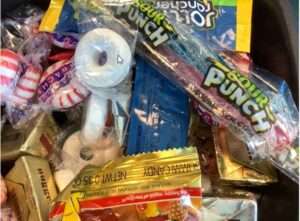
Candy — Kantiiq
Kantiit neqnirtartut.—Candies are sweet.
Candy is any food in which sugar, or a similar sweetener, is the main ingredient. The common Alutiiq word for candy—kantiiq comes directly from English. However, some Alutiiq speakers use the term neqnisqaq, which means something sweet, or kan’guitaq, an Alutiiq version of the Russian word for candy.
Candy and sugar are recent introductions to the Alutiiq world, brought to Alaska by European traders. The traditional Alutiiq diet is naturally low in sugar and other carbohydrates. Fish, mammals, birds, and shellfish provided ample amounts of meat and fat. They were supplemented with plant foods like spring greens, summer berries, and marine algae that provided modest quantities of carbohydrate. This changed with the introduction of refined carbohydrates like flour and sugar.
By at least 1820, sugar was among the goods traded to Alutiiq people by colonists. Like tea and tobacco, sugar was a popular commodity, widely used and sought after. Sea otter hunting parties received an allotment of sugar among their provisions. By the turn of the twentieth century, sugar was more widely available through cannery stores. Here Alutiiq families bought goods in bulk, including flour, tea, and sugar. Candy was also likely sold, as commercial candy manufacturing in the United States accelerated in the mid 1800s. A visitor to Karluk homes about 1890 wrote about a popular way to eat sugar. People spread brown sugar on a plate, wet it, allow it to dry. Then, they broke pieces off the hard sugar cake to suck on between sips of tea.
Listen to podcast at Alutiiq Museum website
